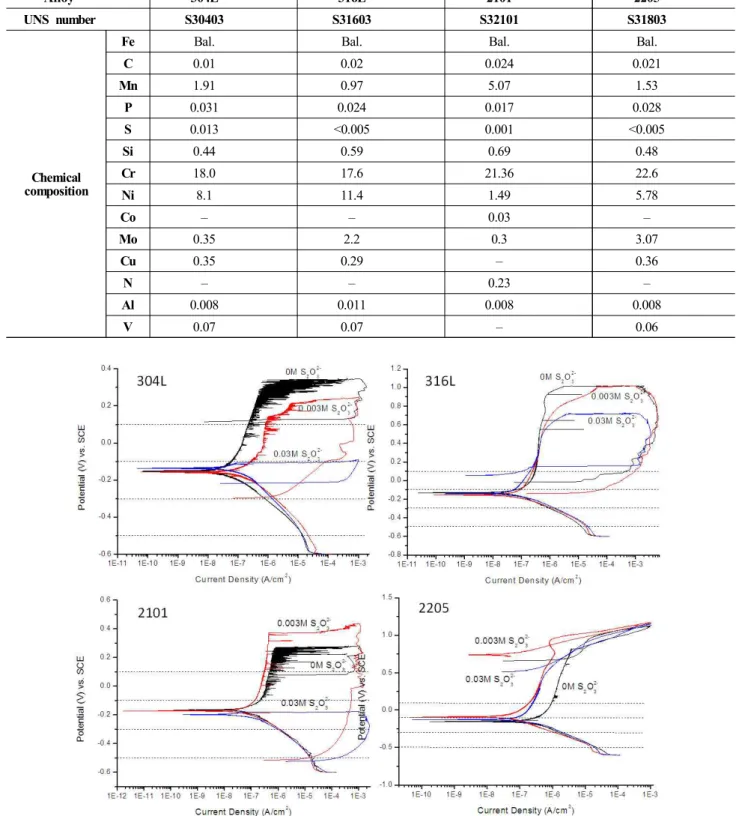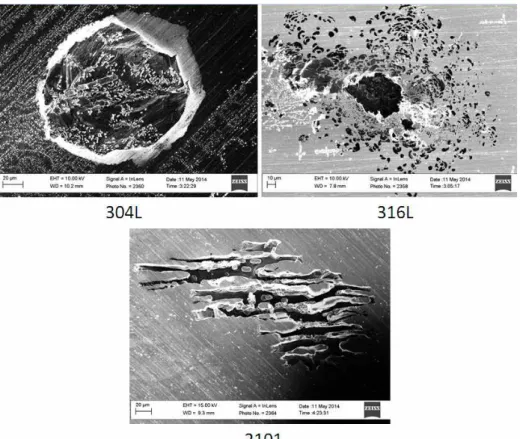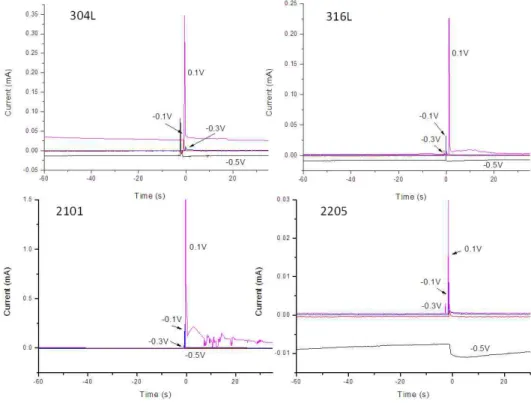Corrosion and Repassivation Behavior of Stainless steels in Chloride and Thiosulfate Containing Environments
Y. S. Wang† and P. M. Singh
School of Materials Science and Engineering, Georgia Institute of Technology, Atlanta, GA, U.S.A.
(Received July 23, 2015; Revised July 29, 2015; Accepted July 29, 2015)
In this study, the combined effect of chloride and thiosulfate ions and the effect of the ratio of the two ions on passivation in 304L, 316L, and the duplex stainless steels 2101 and 2205 are investigated using potentiostatic scratch tests. Cyclic polarization and the scratch tests were used to understand the role of anions on localized corrosion in these systems. It was found that the thiosulfate pitting began at a lower potential for 2101 than 304L in 0.6 M NaCl + 0.03 M Na2S2O3 solution. The pit morphologies for 304L, 316L, and 2101 in an 0.6 M NaCl + 0.03 M Na2S2O3 solution were very different from each other. The results indicate that the pitting switches from predominately thiosulfate pitting to chloride pitting at approximately 0.1 V.
Keywords : stainless steel, chloride, thiosulfate, pitting, repassivation, pit morphology
†Corresponding author: ywang.gatech@gmail.com
1. Introduction
Thiosulfate anions are common to many industries, such as the oil industry and the pulp and paper industry.
Thiosulfate ions may be produced due to the oxidation of sulphides and elemental sulfur, or form by the reduction of sulphate due to bacterial activities1,2). When thiosulfate is combined with the ubiquitous chloride ions, the water chemistry may become quite aggressive and cause lo- calized corrosion in many grades of stainless steels3-6). Thiosulfate pitting was reported to be most severe when the molar ratio of (chloride + sulphate) to thiosulfate is between 10 and 307-10). Thiosulfate was found to be much less aggressive to passive film compared to bare metal surface7), and the pitting occurs in the range of -325 mV to -100 mV for a Fe-19Cr-10Ni alloy in solutions contain- ing only sulphate and thiosulfate ions. Alloys with an higher nickel content was found to be more susceptible to thiosulfate pitting11); while the addition of molybdenum to the alloy has a positive effect on thiosulfate pitting re- sistance10,12).
Duplex stainless steels are used more often in industrial applications in recent years, due to their higher strength and superior corrosion and stress corrosion cracking resist- ance in many environments. However, the amount of liter- ature on the thiosulfate pitting of duplex stainless steels
is limited. No mechanistic study on the pitting of duplex stainless steels in thiosulfate and chloride containing envi- ronments is available so far. It is the aim of this study to understand the effect of thiosulfate concentration and applied potential on the pitting of two austenitic stainless steels (304L and 316L) and two grades of duplex stainless steels (2205 and 2101).
2. Experimental Procedure
Mill-annealed austenitic stainless steels 304L, 316L, du- plex stainless steels 2101 and 2205 were used in this study. Chemical compositions of these alloys are given in Table 1.
Corrosion tests were carried out in simulated paper ma- chine environment (white water environment) which typi- cally contains the varying concentrations of chloride, sul- phate, and thiosulfate ions. Simulated paper machine white water was made from deionized (DI) water and American Chemical Society (ACS) reagent grade sodium chloride, sodium sulphate, and sodium thiosulfate.
In cyclic potentiodynamic testing, samples were mount- ed in an epoxy mould and polished to 2000 grit. Punched electroplating tape was applied on the polished sample to avoid crevice corrosion. Experiments were carried out in naturally aerated solutions at room temperature. The potential was swept from -0.6 V vs. SCE to 1.2 V vs.
SCE or until reaching a current density of 1 mA/cm2, usu- ally due to pitting. The forward scan rate was set to 0.1
Table 1. Chemical composition of steels used in this study (wt%)
Alloy 304L 316L 2101 2205
UNS number S30403 S31603 S32101 S31803
Chemical composition
Fe Bal. Bal. Bal. Bal.
C 0.01 0.02 0.024 0.021
Mn 1.91 0.97 5.07 1.53
P 0.031 0.024 0.017 0.028
S 0.013 <0.005 0.001 <0.005
Si 0.44 0.59 0.69 0.48
Cr 18.0 17.6 21.36 22.6
Ni 8.1 11.4 1.49 5.78
Co – – 0.03 –
Mo 0.35 2.2 0.3 3.07
Cu 0.35 0.29 – 0.36
N – – 0.23 –
Al 0.008 0.011 0.008 0.008
V 0.07 0.07 – 0.06
Fig. 1. Cyclic polarization curves for all samples in all solutions used in this study.
mV/s. Backward scan rate was set to 1.5 mV/s to avoid pit overgrowth. Polarized samples were examined for any signs of crevice attack under the tape. If there were any
signs of crevice corrosion on the sample, that data was not used in this paper.
Scratch tests for pitting and the repassivation kinetics
Fig. 2. Pit morphology of 304L, 316L, and 2101 after cyclic polarization measurements in 0.6 M NaCl + 0.03 M Na2S2O3 solution.
study were carried out under potentiostatic polarized con- ditions at the room temperature. Samples of 3 mm in width were mounted in epoxy mould and polished to 2000 grit.
The samples were polarized at different potentials (-0.5 V, -0.3 V, -0.1 V, and 0.1 V vs. SCE) for 120 seconds before the scratch was made to disrupt the surface passive film. Current transients were monitored for 35 seconds after the scratch. Approximately 80 µm-wide scratches across the sample thickness were made using a dia- mond-tip scriber. All electrochemical tests were carried out using Gamry Reference 600 potentiostat.
3. Results and Discussion
To study the effect of thiosulfate ions, a baseline sol- ution of 0.6 M NaCl was chosen and various concen- trations of thiosulfate were added to it. Cyclic polarization measurements and potentiostatic scratch tests were carried out in different solutions, as shown in Fig. 1.
The localized corrosion is usually shown as a hysteresis loop in cyclic polarization curves. Dashed lines in Fig.
1 are the four selected potentials at which potentiostatic scratch tests were carried out. For 2205 alloy, only meta- stable pitting is observed in the polarization curves shown in Fig. 1. Hysteresis loop, indicative of stable localized
corrosion, was not shown by the cyclic polarization tests, as shown on all three curves for the tests done in solutions containing different amounts of thiosulfate ions. On the other hand, hysteresis loop is very clearly seen for the three equivalent environments on all other alloys tested.
The pitting potentials are lowered for all samples when the molar ratio of chloride to thiosulfate is 20, compared to the pitting potentials in solutions with chloride alone.
Another observation is that the repassivation potentials significantly decreased in the presence of thiosulfate ions, similar to what we observed in an earlier study13). The degree of the lowering of repassivation potential varies for different alloys. Alloy 316L is the most resistant to this effect of thiosulfate. On the other hand, repassivation potential of 2101 decreases to around -500 mV vs. SCE, compared to around -200 mV vs. SCE for 304L. Pit mor- phology is also very different among the three samples that showed pitting. SEM images of the pit morphology for the three pitted samples in 0.6 M NaCl 0.03 M Na2S2O3 solution is shown in Fig. 2.
A round pit opening is observed for 304L samples, which is similar to what had been reported in the literature for thiosulfate pitting in 304L14). On the other hand, 316L showed lacy pit morphology15). Usually the lacy pit is con- sidered to be more dangerous since the porous passive
Fig. 3. Current Transients of tested steel samples in 0.6 M NaCl solutions.
Fig. 4. Current Transients of tested steel samples in 0.6 M NaCl + 0.003 M Na2S2O3 solutions.
layer provides only a diffusion path for the ions, and the lacy pit would not repassivate until convection occurs after the passive film is damaged. In this case, however, the
316L alloy is more resistant to the thiosulfate pitting, which can be concluded from both cyclic polarization and scratch tests. This is attributed to the addition of molybde-
Fig. 5. Current Transients of tested steel samples in 0.6 M NaCl + 0.03 M NaSO solutions.
num10). It can be inferred that thiosulfate inhibited the re- passivation process in 304L13), resulting in a more ag- gressive pitting process. In the case of 2101, on the other hand, preferential dissolution in the ferritic phase was observed. A proposed mechanism is that the preferential dissolution of the ferritic phase is due to chloride pitting16). The thiosulfates inhibited the repassivation process, turn- ing a metastable pit into a stable pit, preferentially on the ferrite phase. Further research is required to prove this theory.
The current transients for the tested samples, during the scratch tests, in solutions with 0.6 M NaCl are shown in Fig. 3. The current transients from 60 seconds before the scratch and 35 seconds after were displayed.
All samples repassivated after the scratch was made un- der tested applied potentials. However, local activities after the scratch were shown on 304L, 316L, and 2101 samples at 0.1 V vs. SCE, as was expected based on the cyclic polarization measurements. No stable pitting was observed after the scratch in solutions with only 0.6 M NaCl. With the addition of 0.003 M Na2S2O3, repassivation process is different, as shown in Fig. 4.
In the 0.6 M NaCl + 0.003 M Na2S2O3 solution, 2101 showed local activities after the scratch at both -0.3 V and 0.1 V vs. SCE. Local activities were observed for both 304L and 316L at 0.1V. 2205 again completely re- passivated after the scratch.
In the case of 0.6 M NaCl + 0.03 M, as shown in Fig. 5. All 2205 samples repassivated after the scratch.
However, stable pitting after the scratch was observed for both 304L and 2101. Current fluctuations after scratch were found for 316L at 0.1 V but no stable pitting was seen. Stable pitting starts for 2101 from -0.3 V and above, while stable pitting starts from -0.1 V for the 304L samples. It is important to note that the pitting tendency is stronger for the 2101 duplex stainless steel at -0.1 V than at 0.1 V. Amount of black corrosion product de- creased for the pits formed at the applied potential of 0.1 V compared to -0.1 V. It is most likely due to the lower tendency of the formation of reduced sulfur species when the sample is polarized at a higher potential, which was demonstrated in literature7). This suggests that the pitting mechanism is switching from a thiosulfate pitting domi- nated process to a more chloride pitting dominated process.
Combining the results from cyclic polarization measure- ments and potentiostatic scratch tests, it is easy to see that the corrosion resistance for 2205>316L>304L>2101 in 0.6M NaCl solutions with addition of various concen- trations of thiosulfate up to a molar ratio of chloride to thiosulfate of 20.
4. Conclusions
Cyclic polarization measurements and potentiostatic
scratch tests were carried out to study the effect of thio- sulfate on the pitting and repassivation properties of 304L, 316L, 2101, and 2205. Duplex stainless steel 2205 showed no localized corrosion in all tested solutions. Pitting poten- tial is lowered when the molar ratio of chloride to thio- sulfate is 20, compared to pitting potential in solutions with chloride ions alone. Repassivation potential decreases in the presence of thiosulfate, with a largest decrease for the lean duplex stainless steel 2101. Pit morphology is very different for 304L, 316L, and 2101 alloys, which suggested different pitting and repassivation mechanisms for these alloys due to the differences in the alloy compo- sition as well as the microstructure. Thiosulfate pitting starts at lower applied potentials for 2101 than for 304L, probably due to a preferential dissolution of the ferritic phase. It was also found that the pitting mechanism may change from a thiosulfate pitting dominated mechanism to a chloride pitting dominated mechanism.
Acknowledgments
Authors would like to thank the Renewable Bioproducts Institute, Georgia Institute of Technology for the PSE graduate research fellowship. Financial and technical sup- port of the RBI member companies is also acknowledged.
References
1. T. Hakkarainen, Mater. Corros., 54, 503 (2003).
2. A. Garner, Corrosion, 67, 65006 (2011).
3. J.-J. Park and S.-I. Pyun, Corros. Sci., 46, 285 (2004).
4. H.-S. Kuo, H. Chang, and W.-T. Tsai, Corros. Sci., 41, 669 (1999).
5. V. Rajan and G. Was, Corrosion, 43, 305 (1987).
6. D. B. Wells, J. Stewart, R. Davidson, P. M. Scott, and D. E. Williams, Corros. Sci., 33, 39 (1992).
7. R. Newman, Corrosion, 41, 450 (1985).
8. R. C. Newman, W.P. Wong, H. Ezuber, and A. Garner, Corrosion, 45(4): p. 282 (1989).
9. E. Abd El Meguid, N. Mahmoud, and S. Abd El Rehim, Mater. chem. phys., 63, 67 (2000).
10. N. Laycock, Corrosion, 55, 590 (1999).
11. R. Roberge, Corrosion, 44, 274 (1988).
12. A. Elbiache and P. Marcus, Corros. Sci., 33, 261 (1992).
13. Y. Wang and P. M. Singh, Proceedings of the CORROSION 2014 on Corrosion Behavior of Duplex Stainless Steels in Paper Machine White Water, San Antonio, TX (2014).
14. T. Laitinen, Corros. Sci., 42, 421 (2000).
15. P. Ernst, N. Laycock, M. Moayed, and R. Newman, Corros. Sci., 39, 1133 (1997).
16. E. Symniotis, Corrosion, 46, 2 (1990).



